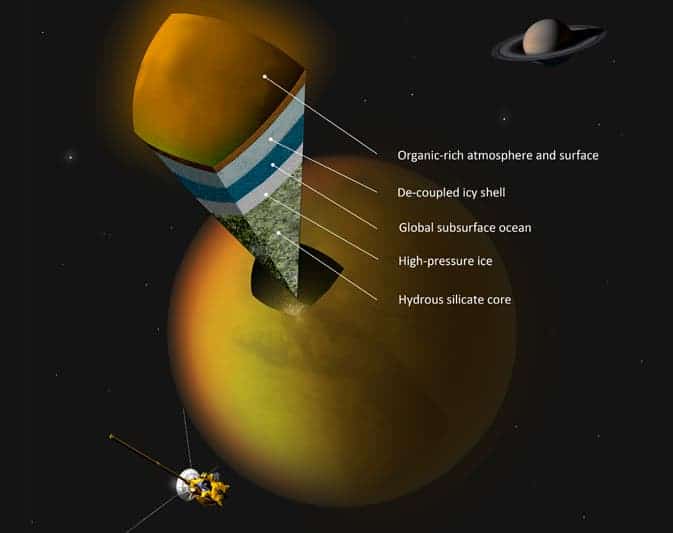Last year, we reported on this incredible study from NASA scientists, where the possibility of a vast ocean of water beneath the surface of Titan, one of Saturn’s moon, was discussed. The study was in its incipient form, and now researchers have released a new report in which they conclude it’s very much likely that a huge ocean of liquid water might exist on Titan.

Artist impression of a possible scenario for the internal structure of Titan. (c) NASA
Though just a satellite, Titan is bigger than Mercury, the innermost of the eight planets in the Solar System, and many respects resembles our very own planet during its early days. Previously, it’s been determined that Titan’s surface is home to numerous methane lakes, one of them half as large as Utah’s Great Salt Lake; very similar to how the Earth looked like billions of years ago. Were it not so far away from the Sun’s warm, life-giving rays, who knows what might have happened; geologically-speaking though, Titan is an extremely interesting body to study, offering a glimpse in Earth’s distant past.
“The search for water is an important goal in solar system exploration,” said lead author Lucino Iess, a Cassini scientist at Sapienza University in Rome. “Now we’ve spotted another place where it is abundant.”
The Cassini spacecraft orbits around Saturn every 16 days, but i’s orbit isn’t circular because of strong gravitational forces exerted by the nearby planet. During six flybys of Titan from 2006 to 2011, Cassini gathered radio-metric tracking and optical navigation data from which investigators could roughly infer the changing shape of the moon. They deduced that if Titan were composed entirely of stiff rock, the gravitational attraction of Saturn would cause bulges, or solid “tides,” on the moon only 3 feet (1 meter) in height – composition greatly influences deformation.
Spacecraft data show Saturn creates solid tides approximately 30 feet (10 meters) in height, which suggests Titan is not made entirely of solid rocky material; in fact, “[…]the density of Titan is consistent with a body that is about 60% rock and 40% water,” says planetary scientist Jonathan Lunine, of Cornell University, one of the co-authors of the paper. “The ocean must be fairly thick — a few hundred kilometers. And it must lie relatively close to the surface — beginning no farther down than 100 kilometers.”
Of course, it doesn’t necessarily have to be water; computations so far show the presence of a subterranian liquid. For all we know it could very well be covered in methane, however water is the most solid bet.
“It’s a matter of what’s abundant in the solar system,” Lunine says. “Water is far and away one of the most abundant substances. Europa, as well its sister moons Ganymede and Callisto are covered with water ice like Titan. Rock and metals are similarly plentiful. All this hangs together to suggest what the interior of Titan is like.”
Life on Titan
Water, in liquid form, is the first thing scientists are looking for when investigation for signs of extraterrestrial life. In this case, on Titan the presence of a subsurface layer of liquid water is not itself an indicator for life. Scientists think life is more likely to arise when liquid water is in contact with rock, and these measurements cannot tell whether the ocean bottom is made up of rock or ice. The results have a bigger implication for the mystery of methane replenishment on Titan.
“The presence of a liquid water layer in Titan is important because we want to understand how methane is stored in Titan’s interior and how it may outgas to the surface,” said Jonathan Lunine, a Cassini team member at Cornell University, Ithaca, N.Y. “This is important because everything that is unique about Titan derives from the presence of abundant methane, yet the methane in the atmosphere is unstable and will be destroyed on geologically short timescales.”
The finding appears in today’s edition of the journal Science.
source: NASA









